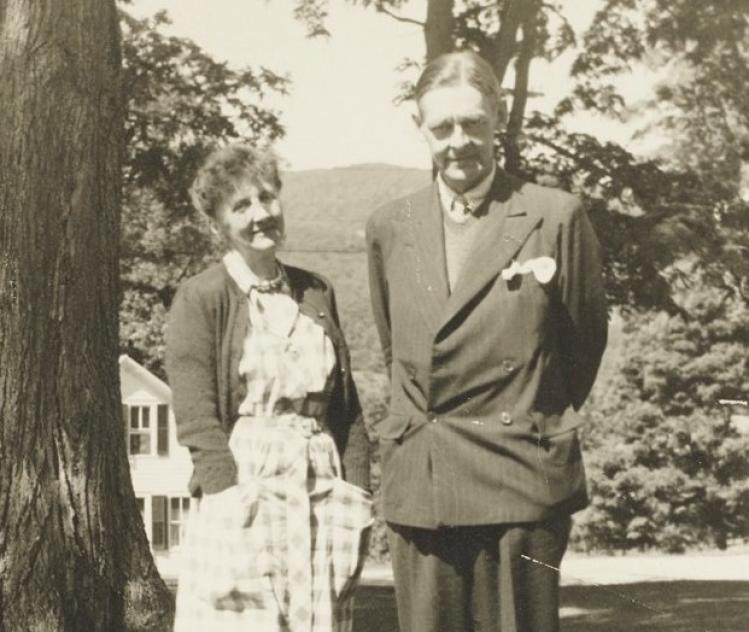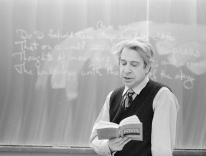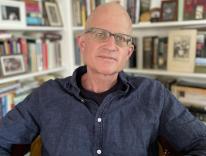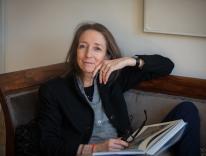
On January 2, 2020, letters that had been sealed for over sixty years at Princeton’s Firestone Library were opened for the first time, revealing one side of an epistolary romance that spanned three decades. The couple in question was the great twentieth-century poet T. S. Eliot and his first love, the Boston-born Emily Hale. Although Eliot burned Hale’s letters to him after marrying a different woman, his letters to her paint an astonishing picture of the passion that animated both his poetry and his turn toward God. The letters are stored in dozens of boxes. Stationery from Eliot’s place of work, inky and at times hard-to-decipher handwriting, and marginalia all attest to their raw composition. The terms of endearment are overwhelming: “My Emily,” “Emily Dear,” “My Love,” “My dove,” “My only Love,” “My saint,” “My Lady.”
Born in 1891, Emily Hale belonged to the same elite social milieu as the Eliots. Her family lived in Boston, where her father was a Unitarian minister. She was a budding young actress who would later become a teacher at various women’s colleges, including Scripps College in California. She died unmarried in 1969, her relationship with T. S. Eliot the great secret of her life.
Before the letters from the Hale Archive were released, it was believed that Eliot met and fell in love with Hale in 1912, while he was a graduate student at Harvard. Now we know that Eliot and Hale met seven years earlier than previously thought. As scholar Frances Dickey has discovered, seventeen-year-old Eliot was brought to the Hale household in 1905, where the two met as children. He almost proposed to her in 1914, but instead left for graduate school in England, where he settled and married.
Eliot and Hale began their correspondence after a chance encounter in 1930. At that time, Eliot was in the midst of a painful marriage to his first wife, Vivienne Haigh-Wood. He described that marriage as a “nightmare agony” that “brought the state of mind out of which came The Waste Land.” Yet even in that poem there are glimpses of bliss.
You gave me hyacinths first a year ago;
“They called me the hyacinth girl.”
—Yet when we came back, late, from the Hyacinth garden,
Your arms full, and your hair wet, I could not
Speak, and my eyes failed, I was neither
Living nor dead, and I knew nothing,
Looking into the heart of light, the silence.
Scholars have long speculated about a seemingly consistent character present in Eliot’s verse and plays: this hyacinth girl in The Waste Land, “the lady of silences” in “Ash Wednesday,” the poet’s companion in “Burnt Norton,” Celia in The Cocktail Party. With the publication of these letters, we have Eliot’s word that Hale is the “hyacinth girl,” that “Burnt Norton” was Eliot’s “love poem” for her, and that Eliot felt that no one else would “ever understand” his conversion poem “Ash Wednesday,” except for Emily Hale.
Eliot maintained that it wasn’t carnal love that attracted him to Emily Hale. She was, to him, no mere woman, but a beam of light. In his first letter to her, he writes that loving Hale “helped me to the Church and to the struggles of the spiritual life: and in the midst of agony a deep peace… ‘not as the world giveth’— but the peace of God.” In the margin, he adds that his love for Emily “has become to me a part of the Love which ‘overcomes the world.’”
Through these words, Eliot self-consciously employs a trope that stretches back to Dante’s love for Beatrice: the donna angelicata, or angelic woman. This heavenly character serves as literary and theological muse to a typically male figure. Beatrice’s love and intercession from heaven saves Dante from his dark wood. She guides him through the celestial spheres, ultimately pointing him toward God, assuring him that “Not in my eyes alone is Paradise.”
In much the same way, Eliot felt that Emily Hale had helped him, wittingly or not, along his spiritual pilgrimage. Eliot shocked his contemporaries when he became an Anglican in 1927, prompting his friend Virginia Woolf to write in her diary that Eliot was “dead to us all from this day forward.” It was difficult for Eliot’s peers to understand how the author of the despairing “The Love Song of J. Alfred Prufrock” and nihilistic “The Hollow Men” would join the church.
In a letter from 1930, three years after his conversion, Eliot writes “there were many concurrent paths bading me to the Altar—but I doubt whether I should have arrived but for you.” Eliot became an Anglican before he began correspondence with Hale. And yet, he maintains that the love he had long felt for her played a determining role in his conversion. In one letter he writes, “my love for you has steadily grown into something finer and finer.”
But Hale never intended to be a muse. Frances Dickey remarks that she “gets the sense from numerous letters that [Hale] was cautioning [Eliot] not to idealize her,” echoing Beatrice’s warning in Paradiso. Eliot had penned a canonical essay on Dante and populated his poetry with inscriptions and allusions to the great Florentine poet. The parallel must not have been lost on him, as he found himself in the midst of a love that seemed a saving grace.
When Eliot’s wife Vivienne died in 1947, Hale expected Eliot to make good on his longstanding promise of marriage. Instead, he wrote that he believed he was absolutely unsuited for matrimony, while still maintaining that “it is you or nobody.” But in 1957, he married Valerie Fletcher, his personal secretary at Faber & Faber who was thirty-eight years younger than him.
Eliot had initially gloried over his correspondence with Hale, planning for its preservation at the Bodleian Library and its eventual opening to the public. But after his marriage to Fletcher, and after hearing that Hale had written a narrative of their relationship to accompany the gift of his letters to Princeton Library (a gift he had at least initially approved) Eliot arranged for another letter to be released on the same day, sixty years after his death, by Harvard’s Houghton Library. In that letter, the man who had once offered to enshrine their love letters in the Bodleian disowns his relationship with Emily Hale from beyond the grave, stating that they had “little in common,” before insinuating that she associated with him because of his fame. He recalls a fight they had over Hale’s taking communion in an Episcopalian church, an act he viewed as sacrilegious because she was a Unitarian. Eliot calls his love for Hale “the love of a ghost for a ghost” before closing the letter with praise for the rightness of his marriage to his second wife Valerie.
Eliot’s cold words in his last “letter” to Hale feel out of keeping with the trove of correspondence at the Firestone. Filled with vulnerability, desire, and shared understanding, those letters to Hale testify to a relationship altogether more complex.
Emily Hale waited for a man who would not follow through on his commitment to her, a man who, seeing her through rose-tinted glasses, ignored her actual personhood. In the end, she died unmarried and without any recognition despite being the main source of inspiration for one of the twentieth century’s greatest poets. She writes: “I was the confidante by letters of all which was pent up in this gifted, emotional, groping personality.” Frances Dickey notes that Hale “did not get a penny of the riches that [Eliot] made from his poetry and drama, much of which was inspired by her.” Hannah Sullivan, another eminent Eliot scholar, speculates: “Perhaps by not marrying her, [Eliot] kept her at a permanently fruitful distance.”
Because Eliot burned his letters from Hale, we will never be able to read her side of the love story. But the collection at the Firestone does include her after-the-fact narrative of what happened between them. She is, as some have pointed out, a “proper Bostonian” about the whole affair, reticent and decorous, but she was no stony “lady of silences.” She reflects on the “shock and sorrow” she experienced when Eliot married Valerie, but retains composure and grace: “Looking back on the story, perhaps I could not have been the companion in marriage I hoped to be, perhaps the decision saved us both from great unhappiness I cannot ever know.” She took consolation in the fact that “the memory of the years when we were most together and so happy are mine always and I am grateful that this period brought some of his best writing, and an assured charming personality which perhaps I helped to stabilize.”
Eliot passed away having achieved marital bliss, career success, and spiritual resolution. Dickey notes, “He had a new narrative to his life, which was that his love for Valerie was the apotheosis of his long-deferred happiness, but it wasn’t the full story.” Meanwhile, Hale’s wish was for future scholars and biographers to “learn the truth about us.” A little more than half a century after her death, we finally will. The records of her relationship with T. S. Eliot, contained in more than thirty boxes, are neatly catalogued. In one letter, Eliot writes: “I always kiss your letters on the word ‘Emily.’”
Please email comments to [email protected] and join the conversation on our Facebook page.
Previous Story
Sex & ‘the Human Focus’
Next Story
Already & Not Yet


